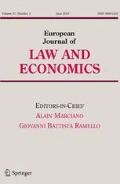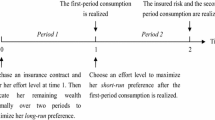Abstract
Empirical evidence shows that consumers are often subject to a projection bias, such as they exaggerate the degree to which their future tastes will resemble their current ones. Such biases are particularly acute when consumers commit to a long-term contract. This paper aims at assessing the consequences of projection bias and at defining when a legal intervention is relevant. In this perspective, we compare the situation of naive and sophisticated agents, both with and without regulation regarding contract duration and early termination fees. The demand side of the market consists either of sophisticated agents, who perfectly anticipate their future willingness to pay (WTP); or of naive consumers, who exhibit a projection bias. The supply side is a monopoly offering long- and short-term contracts. Our main contribution consists in showing that naive consumers are not always worse off than sophisticated agents. The key parameter is how willingness to pay varies over time. If consumers have an increasing WTP for a given service or product, naive agents can actually be better off than sophisticated ones. We argue that naivete protects consumers against a price increase. However, naivete also leads to less exchanges on the market, thus generating a deadweight loss. Hence, the overall effect of naivete on social welfare is ambiguous. As far as public policy is concerned, we conclude that regulating contract duration is only relevant in some circumstances, depending on the market characteristics and on the bias.


Similar content being viewed by others
Notes
For an interesting review, see the report issued by the Office of Fair Trading in 2003 entitled “Switching Costs. Part One: Economic Models and Policy Implications” Office of Fair Trading (2003).
Directive 2009/136/EC of the European Parliament and of the Council of 25 November 2009 amending Directive 2002/22/EC on universal service and users’ rights relating to electronic communications networks and services.
The European directive has been transposed in French law at articles L.224-26 through L.124-42 of the French Consumer Code.
For example in France, the penetration rate of sim cards reached 120.5% in september 2014 according the French Regulation Authority of Communication, ARCEP (2015).
The subscripts s and n are only used when necessary to distinguish between contracts aimed at naive consumers from the ones designed for sophisticated agents.
When the market is regulated, the model does not allow for \(x_1 \ne x_2\) as explained in Sect. 5. In that case, we do not need to distinguish between \(x_1\) and \(x_2\) (see p. 23).
This obligation stems from European Directive 2009/136/EC of 25 November 2009.
As we write the firm’s program, we denote \(x^S\) and \(x^L\) quantities offered respectively in the short-tem and the long-term contract so that the reader can understand where each constraint comes from. As we solve the model, since \(x^L=x^S\) as explained p. 23, we simplify the notation to x.
Solving the model by saturating any other constraints leads to a contradiction.
Recall that functions u, v and z are assumed to be linear (see above system (1) p. 10). This assumption ensure that \(\theta _1\) and \(\theta _2\) each have a unique value.
For the contract set (L, S), prices are equal to \(P^L=\frac{u(x)}{1+\theta }\) and \(P^S_2=v(x)\). Quantities are equivalent to the ones offered in the contract set (S, S).
References
ARCEP. (2015). Observatoire des marchés des communications électroniques en france. Les Actes de l’ARCEP, Autorité de Régulation des Communications Eléctroniques et des Postes.
Ariely, D., & Loewenstein, G. (2006). The heat of the moment: The effect of sexual arousal on sexual decision making. Journal of Behavioral Decision Making, 19, 87–98.
Bar-Gill, O., & Ben-Shahar, O. (2014). Exit from contract. Journal of Legal Analysis, 6(1), 151–183.
Bar-Gill, O., & Stone, R. (2009). Mobile misperception. Harvard Journal of Law and Technology, 23(1), 51–118.
Belleflamme, P., & Peitz, M. (2010). Industrial organization: Markets and strategies (1st ed.). Cambridge: Cambridge University Press.
Busse, M., Pope, D., Pope, J., & Silva-Risso, J. (2015). The psychological effect of weather on car purchases. The Quarterly Journal of Economics, 130(1), 371–414.
Conlin, M., O’Donoghue, T., & Vogelsang, T. (2007). Projection bias in catalog orders. American Economic Review, 97(4), 1217–1249.
DellaVigna, S. (2009). Psychology and economics: Evidence from the field. Journal of Economic Literature, 47(2), 315–372.
DellaVigna, S., & Malmendier, U. (2004). Contract design and self-control: Theory and evidence. Quarterly Journal of Economics, 119(2), 353–402.
DellaVigna, S., & Malmendier, U. (2006). Paying not to go to the gym. American Economic Review, 96(3), 694–719.
Eliaz, K., & Spiegler, R. (2006). Contracting with diversely naive agents. Review of Economic Studies, 73(3), 689–714.
Elster, J. (1996). Rationality and the emotion. The Economic Journal, 106(438), 1386–1397.
Frey, B., & Stutzer, A. (2013) Economic consequences of mispredicting utility. Technical Report 3, German Social-Economic Panel Study.
Gabaix, X., & Laibson, D. (2006). Shrouded attributes, consumer myopia, and information suppresion in competitive markets. The Quarterly Journal of Economics, 121(2), 505–540.
Gilbert, D., Gill, M., & Wilson, T. (2002). The future is now: Temporal correction in affective forecasting. Organizational Behavior and Human Decision Processes, 88(1), 430–444.
Kahneman, D. (2011). Thinking fast and slow. New York City: Farrar, Staus and Giroux.
Kahneman, D., & Snell, J. (1992). Predicting a changing taste: Do people know what they will like? Journal of Behavioral Decision Making, 5, 187–200.
Kahneman, D., & Tversky, A. (1974). Judgment under uncertainty: Heuristics and biases. Science, 185(4157), 1124–1131.
Loewenstein, G. (1996). Out of control: Visceral influences on behavior. Organizational Behavior and Human Decision Processes, 65(3), 272–292.
Loewenstein, G., & Adler, D. (1995). A bias in the prediction of tastes. The Economic Journal, 105, 929–937.
Loewenstein, G., & Frederick, S. (1997). Predicting reactions to environmental change. In M. Bazerman, D. Messick, A. Tenbrunzel, & K. Wade-Benzoni (Eds.), Environment, ethics and behavior (pp. 52–72). San Fransisco: New Lexington Press.
Loewenstein, G., Nagin, D., & Paternoster, R. (1997). The effect of sexual arousal on expectations of sexual forcefulness. Journal of Research in Crime and Delinquency, 32, 443–473.
Loewenstein, G., O’Donoghue, T., & Rabin, M. (2003). Projection bias in predicting future utility. The Quarterly Journal of Economics, 4(118), 1209–1248.
Loewenstein, G., & Schkade, D. (1999). Wouldn’t it be nice: Predicting future feelings. In D. Kahneman & E. Diener (Eds.), Well-being: The foundations of hedonic psychology. New York: Russel Sage Foundation Press.
March, J. (1978). Bounded rationality, ambiguity, and the engineering of choice. The Bell Journal of Economics, 9(2), 587–608.
Office of Fair Trading. (2003). Switching costs. Part one: Economic models and policy implications. Economic Discussion Paper 5, Office of Fair Trading, London.
Read, D., & Loewenstein, G. (1995). Diversification bias: Explaining the discrepency in variety-seeking between combined and separated choices. Journal of Experimental Psychology: Applied, 1(1), 34–49.
Read, D., & van Leeuwen, B. (1998). Predicting hunger: The effects of appetite and delay on choice. Organizational Behavior and Human Decision Processes, 76(2), 189–205.
Schkade, D., & Kahneman, D. (1998). Does living in California make people happier? A focusing illusion in judgements of life satisfaction. Psychological Science, 9(5), 340–346.
Simonson, I. (1990). The effect of purchase quantity and timing on variety-seeking behavior. Journal of Marketing Research, 27(2), 150–162.
Spiegler, R. (2011). Bounded rationality in industrial organization. Oxford: Oxford University Press.
Thaler, R., & Sunstein, C. (2008). Nudge: La méthode douce pour inspirer la bonne décision. Vuibert.
Ubel, P., & Loewenstein, G. (1997). The role of decision analysis in informed consent: Choosing between intuition and systematicity. Social Science and Medecine, 44(5), 647–656.
Author information
Authors and Affiliations
Corresponding author
Additional information
We thank an anonymous referee for stimulating and enlightening comments. We are also grateful to the participants of the 2015 EALE conference in Vienna, of the PhD seminar at the Ecole Normale Supérieure Paris Saclay and of the CRED seminar at University Panthéon-Assas. Finally, we express our gratitude to Farid Toubal and Bertrand Crettez for their advice and support.
Rights and permissions
About this article
Cite this article
Bienenstock, S., Ropaul, M. On the benefits of being naive: the choice of contract duration with projection bias. Eur J Law Econ 45, 469–496 (2018). https://doi.org/10.1007/s10657-017-9569-0
Published:
Issue Date:
DOI: https://doi.org/10.1007/s10657-017-9569-0




